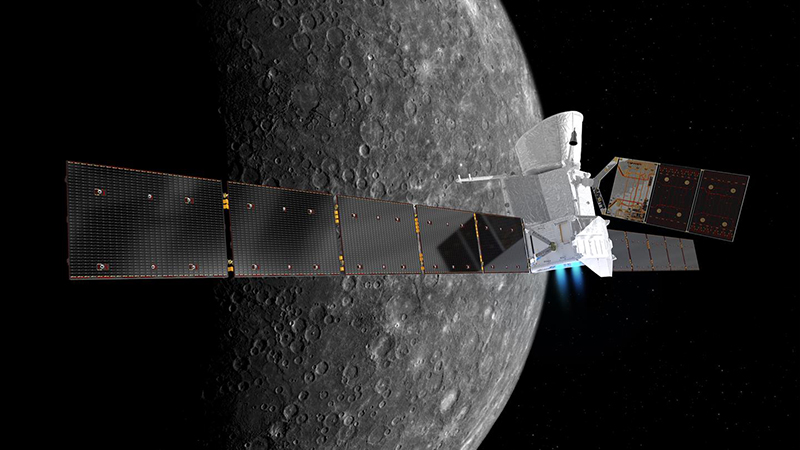The third mission ever to visit the solar system's innermost planet, Mercury, began on October 20, 2018, with the launch of BepiColombo. The mission will attempt to answer longstanding mysteries about Mercury, including its internal structure and interactions with the stream of charged particles streaming off the Sun, known as the solar wind. See also: Mercury (planet); Planet; Solar system; Solar wind; Sun

BepiColombo is a joint mission by the European Space Agency (ESA) and the Japan Aerospace Exploration Agency (JAXA). Each agency has contributed a science orbiter, named the Mercury Planetary Orbiter (MPO) and the Mercury Magnetospheric Orbiter (MMO, or "Mio"), respectively. A cruise stage spacecraft will deliver the two conjoined orbiters to Mercury in 2025 after completing flybys of Earth, Venus, and Mercury itself to shave off momentum and avoid falling into the Sun. Once fully associated with Mercury, the two science vessels will separate from each other and assume different orbits tailored to their particular objectives. See also: Earth; Satellite (spacecraft); Space probe; Venus
MPO's suite of instruments will study and measure Mercury's surface and interior composition, helping to solve the mystery of the planet's disproportionately large iron core. MMO, meanwhile, will focus on examining Mercury's magnetosphere, which is like a weak version of Earth's magnetosphere. Neither Venus nor Mars (the other two terrestrial, rocky planets in our solar system) possesses such a field. Scientists want to learn more about how magnetic fields are generated for geophysical as well as astrobiological reasons, because magnetic fields could play critical roles in allowing for the evolution of surface life by providing shielding from harmful solar radiation. See also: Astrobiology; Earth's core; Extraterrestrial intelligence; Magnetosphere; Mars; Matter (physics); Radiation; Radiation injury to plants and animals
Engineers have built the two BepiColombo spacecraft to withstand the extreme environment at Mercury, where temperatures swing from -180°C (-292°F) to a searing 450°C (850°F). The solar panels on MMO will rotate to maintain the Sun at a low angle, lessening heat damage while still collecting enough sunlight for spacecraft operations. The orbiter also includes a large radiator to efficiently remove heat from the interior of the spacecraft and cast away heat reflected into space by Mercury. As for the MMO's thermal mitigation strategy, the entire body of the orbiter will rotate 15 times a minute, rotisserie-style, to evenly distribute the Sun's blaze. See also: Heat; Solar energy; Space technology; Temperature





